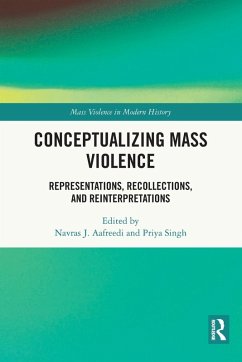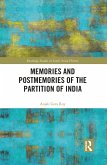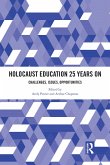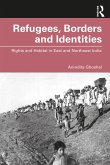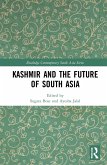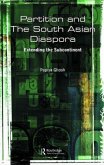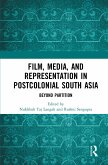Conceptualizing Mass Violence
Representations, Recollections, and Reinterpretations
Herausgeber: Aafreedi, Navras J.; Singh, Priya
Conceptualizing Mass Violence
Representations, Recollections, and Reinterpretations
Herausgeber: Aafreedi, Navras J.; Singh, Priya
- Broschiertes Buch
- Merkliste
- Auf die Merkliste
- Bewerten Bewerten
- Teilen
- Produkt teilen
- Produkterinnerung
- Produkterinnerung
Conceptualizing Mass Violence draws attention to the conspicuous inability to inhibit mass violence in myriads forms and considers the plausible reasons for doing so. Focusing on a postcolonial perspective, the volume seeks to popularize and institutionalize the study of mass violence in South Asia.
Andere Kunden interessierten sich auch für
![Memories and Postmemories of the Partition of India Memories and Postmemories of the Partition of India]() Anjali RoyMemories and Postmemories of the Partition of India63,99 €
Anjali RoyMemories and Postmemories of the Partition of India63,99 €![Holocaust Education 25 Years on Holocaust Education 25 Years on]() Holocaust Education 25 Years on63,99 €
Holocaust Education 25 Years on63,99 €![Refugees, Borders and Identities Refugees, Borders and Identities]() Anindita Ghoshal (Diamond Harbour Womenâ s Department of HistoryRefugees, Borders and Identities74,99 €
Anindita Ghoshal (Diamond Harbour Womenâ s Department of HistoryRefugees, Borders and Identities74,99 €![Kashmir and the Future of South Asia Kashmir and the Future of South Asia]() Kashmir and the Future of South Asia195,99 €
Kashmir and the Future of South Asia195,99 €![Partition and the South Asian Diaspora Partition and the South Asian Diaspora]() Papiya Ghosh (India Patna University)Partition and the South Asian Diaspora154,99 €
Papiya Ghosh (India Patna University)Partition and the South Asian Diaspora154,99 €![Film, Media and Representation in Postcolonial South Asia Film, Media and Representation in Postcolonial South Asia]() Film, Media and Representation in Postcolonial South Asia195,99 €
Film, Media and Representation in Postcolonial South Asia195,99 €![The Ss-Sonderkommando Dirlewanger: A Memoir The Ss-Sonderkommando Dirlewanger: A Memoir]() Rolf MichaelisThe Ss-Sonderkommando Dirlewanger: A Memoir36,99 €
Rolf MichaelisThe Ss-Sonderkommando Dirlewanger: A Memoir36,99 €-
-
-
Conceptualizing Mass Violence draws attention to the conspicuous inability to inhibit mass violence in myriads forms and considers the plausible reasons for doing so. Focusing on a postcolonial perspective, the volume seeks to popularize and institutionalize the study of mass violence in South Asia.
Hinweis: Dieser Artikel kann nur an eine deutsche Lieferadresse ausgeliefert werden.
Hinweis: Dieser Artikel kann nur an eine deutsche Lieferadresse ausgeliefert werden.
Produktdetails
- Produktdetails
- Mass Violence in Modern History
- Verlag: Taylor & Francis Ltd
- Seitenzahl: 290
- Erscheinungstermin: 9. Januar 2023
- Englisch
- Abmessung: 234mm x 156mm x 16mm
- Gewicht: 438g
- ISBN-13: 9780367704063
- ISBN-10: 0367704064
- Artikelnr.: 67516358
- Herstellerkennzeichnung
- Libri GmbH
- Europaallee 1
- 36244 Bad Hersfeld
- gpsr@libri.de
- Mass Violence in Modern History
- Verlag: Taylor & Francis Ltd
- Seitenzahl: 290
- Erscheinungstermin: 9. Januar 2023
- Englisch
- Abmessung: 234mm x 156mm x 16mm
- Gewicht: 438g
- ISBN-13: 9780367704063
- ISBN-10: 0367704064
- Artikelnr.: 67516358
- Herstellerkennzeichnung
- Libri GmbH
- Europaallee 1
- 36244 Bad Hersfeld
- gpsr@libri.de
Navras J. Aafreedi is Assistant Professor of History at Presidency University, Kolkata, and Research Fellow at the Institute for the Study of Global Antisemitism and Policy, New York. His publications include his monograph Jews, Judaizing Movements and the Traditions of Israelite Descent in South Asia. Priya Singh is Associate Director at Asia in Global Affairs (www.asiaingloblaffairs.in). Priya is a political scientist with an interest in issues pertaining to geo-politics, nationalism, post-nationalism, identity, state formation and gender. She has authored, edited and co-edited books on Israel and the Middle East.
Introduction 1. Reading Mass Violence Part 1: Narratives 2. Violence and
Violations: Betrayal Narratives in Atrocity Accounts 3. Holocaust survivors
in Mexico: Intersecting and Conflicting Narratives of Open Doors, Welcoming
Society and Personal Hardships 4. Historical Narratives, the Perpetuation
of Trauma, and the Work of Vam¿k Volkan Part 2: Revisionism &
Reconstruction 5. Holocaust, Propaganda, and the Distortion of History in
the Former Soviet Space 6. The Genocide of 1971 in Bangladesh: Lessons from
History 7. Holocaust Denial and Minimization in the Indian Urdu Press Part
3: Education 8. Holocaust Studies in Australia: Moving from family and
community remembrance to human rights and prevention of mass violence 9.
New Developments in Holocaust & Genocide Education in South Africa: : The
case study of the Johannesburg Holocaust & Genocide Centre 10. A Case of
Naive Normalization? India's Misbeliefs about Hitler and Schooling on the
Holocaust 11. Holocaust Education in India and its Challenges Part 4:
Reflections 12. Sonderkommando Photo 4 and the Portrayal of the Invisible
13. Overcoming "Intimate Hatreds:" Reflections on Violence against Yazidis
14. The State and its Margins: Changing Notions of Marginality in Turkey
Part 5: Trauma 15. Pinochet's Dictatorship and Reflections on Trauma in
Chile: How much have we learned in terms of human rights? Part 6:
Memorialization 16. 'Grassroots' Holocaust Museums: Revealing Untold
Stories 17. Fabric, Food, Song: The Quiet Continuities in Bengali Life
Seventy Years After Partition Part 7: Literature 18. The Failure of Secular
Publics and the Rise of the Jewish Religious Public in Nathan Englander's
For the Relief of Unbearable Urges Part 8: Dialogue & Reconciliation
19.The 2002 Alexandria Summit and Its Follow Up
Violations: Betrayal Narratives in Atrocity Accounts 3. Holocaust survivors
in Mexico: Intersecting and Conflicting Narratives of Open Doors, Welcoming
Society and Personal Hardships 4. Historical Narratives, the Perpetuation
of Trauma, and the Work of Vam¿k Volkan Part 2: Revisionism &
Reconstruction 5. Holocaust, Propaganda, and the Distortion of History in
the Former Soviet Space 6. The Genocide of 1971 in Bangladesh: Lessons from
History 7. Holocaust Denial and Minimization in the Indian Urdu Press Part
3: Education 8. Holocaust Studies in Australia: Moving from family and
community remembrance to human rights and prevention of mass violence 9.
New Developments in Holocaust & Genocide Education in South Africa: : The
case study of the Johannesburg Holocaust & Genocide Centre 10. A Case of
Naive Normalization? India's Misbeliefs about Hitler and Schooling on the
Holocaust 11. Holocaust Education in India and its Challenges Part 4:
Reflections 12. Sonderkommando Photo 4 and the Portrayal of the Invisible
13. Overcoming "Intimate Hatreds:" Reflections on Violence against Yazidis
14. The State and its Margins: Changing Notions of Marginality in Turkey
Part 5: Trauma 15. Pinochet's Dictatorship and Reflections on Trauma in
Chile: How much have we learned in terms of human rights? Part 6:
Memorialization 16. 'Grassroots' Holocaust Museums: Revealing Untold
Stories 17. Fabric, Food, Song: The Quiet Continuities in Bengali Life
Seventy Years After Partition Part 7: Literature 18. The Failure of Secular
Publics and the Rise of the Jewish Religious Public in Nathan Englander's
For the Relief of Unbearable Urges Part 8: Dialogue & Reconciliation
19.The 2002 Alexandria Summit and Its Follow Up
Introduction 1. Reading Mass Violence Part 1: Narratives 2. Violence and
Violations: Betrayal Narratives in Atrocity Accounts 3. Holocaust survivors
in Mexico: Intersecting and Conflicting Narratives of Open Doors, Welcoming
Society and Personal Hardships 4. Historical Narratives, the Perpetuation
of Trauma, and the Work of Vam¿k Volkan Part 2: Revisionism &
Reconstruction 5. Holocaust, Propaganda, and the Distortion of History in
the Former Soviet Space 6. The Genocide of 1971 in Bangladesh: Lessons from
History 7. Holocaust Denial and Minimization in the Indian Urdu Press Part
3: Education 8. Holocaust Studies in Australia: Moving from family and
community remembrance to human rights and prevention of mass violence 9.
New Developments in Holocaust & Genocide Education in South Africa: : The
case study of the Johannesburg Holocaust & Genocide Centre 10. A Case of
Naive Normalization? India's Misbeliefs about Hitler and Schooling on the
Holocaust 11. Holocaust Education in India and its Challenges Part 4:
Reflections 12. Sonderkommando Photo 4 and the Portrayal of the Invisible
13. Overcoming "Intimate Hatreds:" Reflections on Violence against Yazidis
14. The State and its Margins: Changing Notions of Marginality in Turkey
Part 5: Trauma 15. Pinochet's Dictatorship and Reflections on Trauma in
Chile: How much have we learned in terms of human rights? Part 6:
Memorialization 16. 'Grassroots' Holocaust Museums: Revealing Untold
Stories 17. Fabric, Food, Song: The Quiet Continuities in Bengali Life
Seventy Years After Partition Part 7: Literature 18. The Failure of Secular
Publics and the Rise of the Jewish Religious Public in Nathan Englander's
For the Relief of Unbearable Urges Part 8: Dialogue & Reconciliation
19.The 2002 Alexandria Summit and Its Follow Up
Violations: Betrayal Narratives in Atrocity Accounts 3. Holocaust survivors
in Mexico: Intersecting and Conflicting Narratives of Open Doors, Welcoming
Society and Personal Hardships 4. Historical Narratives, the Perpetuation
of Trauma, and the Work of Vam¿k Volkan Part 2: Revisionism &
Reconstruction 5. Holocaust, Propaganda, and the Distortion of History in
the Former Soviet Space 6. The Genocide of 1971 in Bangladesh: Lessons from
History 7. Holocaust Denial and Minimization in the Indian Urdu Press Part
3: Education 8. Holocaust Studies in Australia: Moving from family and
community remembrance to human rights and prevention of mass violence 9.
New Developments in Holocaust & Genocide Education in South Africa: : The
case study of the Johannesburg Holocaust & Genocide Centre 10. A Case of
Naive Normalization? India's Misbeliefs about Hitler and Schooling on the
Holocaust 11. Holocaust Education in India and its Challenges Part 4:
Reflections 12. Sonderkommando Photo 4 and the Portrayal of the Invisible
13. Overcoming "Intimate Hatreds:" Reflections on Violence against Yazidis
14. The State and its Margins: Changing Notions of Marginality in Turkey
Part 5: Trauma 15. Pinochet's Dictatorship and Reflections on Trauma in
Chile: How much have we learned in terms of human rights? Part 6:
Memorialization 16. 'Grassroots' Holocaust Museums: Revealing Untold
Stories 17. Fabric, Food, Song: The Quiet Continuities in Bengali Life
Seventy Years After Partition Part 7: Literature 18. The Failure of Secular
Publics and the Rise of the Jewish Religious Public in Nathan Englander's
For the Relief of Unbearable Urges Part 8: Dialogue & Reconciliation
19.The 2002 Alexandria Summit and Its Follow Up

